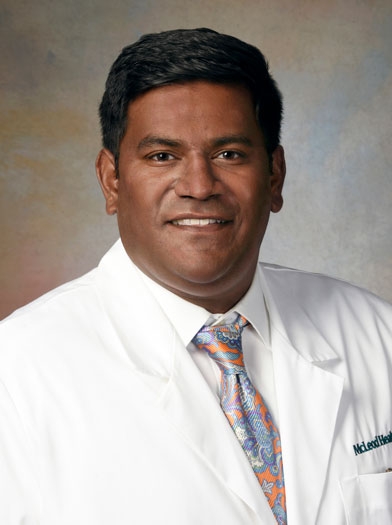Laser Treatment to Remove Cardiac Scar Tissue

Dr. Cyrus Kocherla
McLeod Electrophysiology Services
Implantable devices have been used for decades to treat heart disease – saving or improving the quality of countless lives. These devices provide electrical stimulation to the heart to help maintain normal heart rate and/or rhythm for a heart that is diseased or damaged.
Implantable devices, which include pacemakers and implantable cardioverter defibrillators, are small generators that are placed under the skin in the left or right upper chest area. They are attached to small wires called leads that carry current back to the heart.
Pacemakers help control abnormal heart rhythm rates when it is too slow. They deliver small electrical impulses to stimulate the heart.
Implantable cardioverter defibrillators stop dangerous rapid heart rhythms by delivering an electric shock to bring the heart back to normal rhythm and help regulate rhythms for patients with heart failure.
When a permanent pacemaker or implantable cardioverter defibrillator is implanted, the expectation is that the device will remain in the patient’s body for the rest of their life. But, as with all medical devices, there are circumstances that may require the removal of the system.
The most common reason is device infection usually spreading to the lead from a blood infection or infection in a heart valve. Another cause may be a lead failing to work properly from a break in the metal wire or surrounding insulation. There could also be too much scar tissue accumulated at the tip of a lead affecting device performance. Or, as technology evolves, the patient’s existing device may need to be upgraded with a newer, more effective model.
The body’s natural response to a foreign object, such as a pacemaker, is to form scar tissue surrounding the leads that run through the blood vessels down to the heart. The longer the device is inside the body, the more scar tissue there will be, making removal difficult. Old leads cannot remain in the body as they would interfere with new devices. If the physician is unable to remove the lead with gentle pulling, a special laser extraction device is used.
With the extraction device, a controlled dose of laser energy is applied to break up the scar tissue and free the lead so it can be pulled out.
The laser energy produces pulsed bursts of UV light energy that gently dissolve the fibrous tissue into tiny, microscopic particles which are easily absorbed into the bloodstream.
Sometimes new leads will be implanted during the extraction procedure. It depends on the reason for the lead removal. It is essential any infections be cleared before implanting new leads.
Because of the complex technical requirements, lead extraction should only be performed in specialized centers. Studies have shown that the procedure is more likely to be successful when performed by physicians and medical centers, such as McLeod Regional Medical Center, which have the experience and training in caring for patients in need of lead extractions. The team of medical professionals performing the lead extractions include an Electrophysiologist, a Cardiothoracic Surgeon, an Anesthesiologist, a Nurse and a Surgical Technician.
The laser lead extraction procedure is safe, effective and efficient. As with any surgical procedure, discuss the risks and benefits with your physician before proceeding.
Great strides have been made in the development of guidelines and protocols for lead extraction. The McLeod Heart & Vascular Institute team has been pioneers in developing a program that safely and effectively removes leads for patients in our region.
An electrophysiologist is a physician who specializes in evaluating the abnormalities of the heart’s rhythm. Dr. Cyrus Kocherla is one of three physicians at McLeod whose specialty is in the electrical system of the heart or electrophysiology, a study of the electrical impulses of the heart. Dr. Kocherla is accepting new patients. Appointments with Dr. Kocherla at McLeod Cardiology Associates can be made by calling (843) 667-1891.
-
McLEOD REGIONAL MEDICAL CENTER FLORENCE
843-777-2000 -
McLEOD DARLINGTON
843-777-1100 -
McLEOD DILLON
843-774-4111 -
McLEOD LORIS
843-716-7000 -
McLEOD SEACOAST
843-390-8100 -
McLEOD CHERAW
843-537-7881 -
McLEOD CLARENDON
803-433-3000



-
McLEOD REGIONAL MEDICAL CENTER FLORENCE
843-777-2000 -
McLEOD DARLINGTON
843-777-1100 -
McLEOD DILLON
843-774-4111 -
McLEOD LORIS
843-716-7000 -
McLEOD SEACOAST
843-390-8100 -
McLEOD CHERAW
843-537-7881 -
McLEOD CLARENDON
803-433-3000
 Find a Doctor
Find a Doctor  Locations
Locations  Services
Services